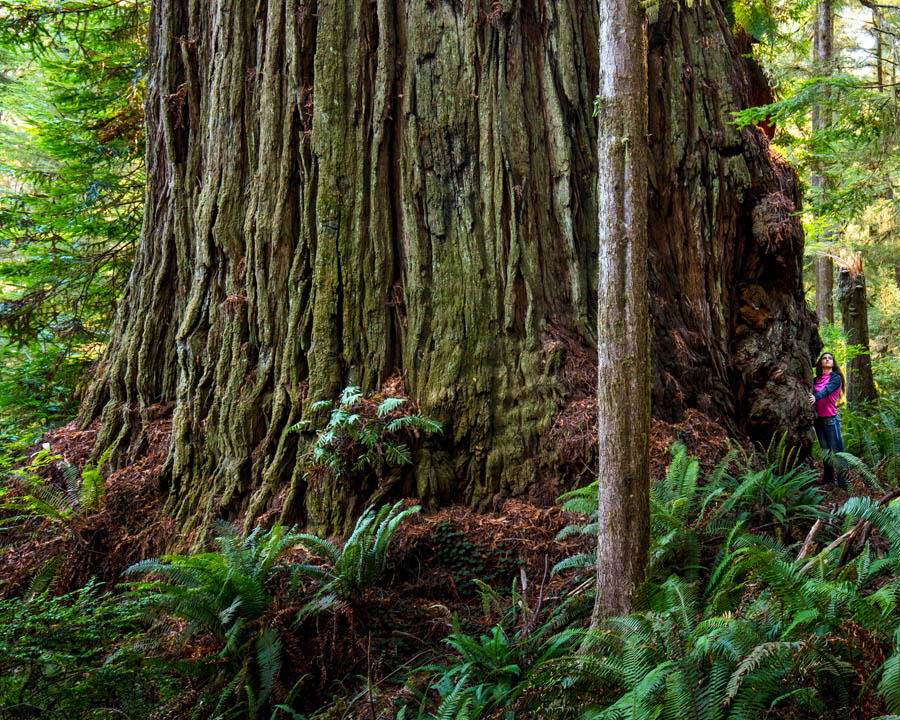
World's widest trunk
Coast Redwood, wider than Giant Sequoia, Montezuma Cypress or Baobab
Continued from: Largest Coast Redwoods
Copyright 2021 by Mario Vaden
This was mentioned with other new discovery information but I wrote this extra page to compare with some other species. Between 2014 and 2015 new discoveries in Redwood National and State Parks moved the Coast Redwood species past Giant Sequoia and even the El Arbol del Tule tree for widest trunk. In other words, meaning a single and "complete" trunk. Unless something falls, the world's widest known trunk diamter is a Coast Redwood which surpassed Giant Sequoia, Baobab and apparently even the Montezuma Cypress in Mexico called El Arbol del Thule. Because photos of the widest Coast Redwood and several others were not released, the Coast Redwood below is provided to illustrate.
Continue reading below this image

A few aspects to review ...
1. Giant Sequoia - For years, quite a few people spoke of widest Giant Sequoias in terms of girth at ground level where the trunk flare is exaggerated. But professionals measure diameter and circumference near chest height known as dbh. If you ever saw diameters listed for Giant Sequioa like 35 ft., that was exaggerated.
2. Coast Redwood - Historically, Coast Redwoods were wider and more massive than Giant Sequoia seen today. The volume was documented, but any Coast Redwoods more massive than General Sherman were cut down or fell in the early 1900s. Between 1930 and the present, Coast Redwoods are often described as the tallest redwoods and Giant Sequoias described as the largest and widest. That left the impression that Coast Redwoods do not grow diameter comparable to Giant Sequoia. Between 2013 - 2015 more Coast Redwoods were discovered. These include trunk diameter and circumference at ground level that surpass all known Giant Sequoia. The world's widest trunk tree is a Coast Redwood with a dbh diameter 29.2'
3. Baobab - Africa has Baobabs with very wide trunks. The largest are two or more trunks and are not the world's widest single trunk They are cool looking organisms though and if you haven't heard of them, search for some of the photos. Almost Disney-like.
4. The Montezuma Cypress, El Arbol del Thule - Regarding the Montezuma Cypress in Santa Maria de Tule, it has been described having a 46 ft. wide trunk. Here's a information check ...
The trunk is very elliptical and does not look so big viewed from the narrow side, rarely shown. The trunk is very buttressed inflating the dbh measurement. The tape literally floats over air much of the way around. I included a diagram below to illustrate all the air space. El Arbol del Tule is most likely fused multiple trunks, evident from seams and included bark evident where individual stems grew together. Over decades, air gaps vanished as opposite bark grew together. Testing was done for DNA in the trunks leading to claims of proof for a single tree. But that is NOT PROOF because trees or reiterations can have the same DNA. This can happen from root sprouts, rooted stem cuttings that were propagated centuries ago or even layering of branches. There are several ways it can happen.
If any arborists reading this have pruned low-branched redcedars or cypress they probably understand this from experience. The low branches root into needle mulch. Those branches can swoop upward, or continue outward producing several extra inner stems. Given time, all that growth can swell diameter and compress into one mass of wood and bark. The DNA would all be the same. The layering and stem growth happens often with western redcedar, Port Orford cedar or Leyland Cypress branches. Even trees like big leaf maple will do it. At Jedediah Smith park's Simpson Reed trail there's a maple with 3 root systems from rooting and layering.
So DNA testing is not proof. It just means the one area of wood and cambium is related to wood and cambium in another area. And it's evident from the appearance that multiple trunks can be a likely cause of the formation.
Apparently, one botanist Juan Bolanos climbed the tree to the point where common trunk ends and primary branches begin and found a large enclosed place "which could serve as a habitation in case of need." This convinced him that the trunk belonged to one individual tree.
Having found hollows in the midst of single and multiple trunks myself, his conclusion isn't persuasive one way or the other. But there's been speculation for a long time that El Arbol del Thule may be at least 3 trunks (http://arnoldia.arboretum.harvard.edu/pdf/articles/475.pdf)
The "nail in the coffin" for El Arbol del Tule being one tree trunk is the inner hollow's characteristics. The inner walls of bark and cambium are inward facing. You just won't find that in nature on existing ancient conifers. For example, if you walk into the "goosepens" (hollows, caves) of some massive redwoods, look at the inner surface. It's dead, rotted or charring due to decay or fire. The cambium and bark are on the outer perimeter continually growing outward. The inside was just wood. The inner room and wall of cambium and bark within El Arbol del Tule is basically the proof that it is not simply just one single trunk.
In the image below, you can see why its girth is exaggerated. The red line represents a tape wrap for diameter. Most of the widest giant sequoia and coast redwood are solid masses of trunk, wood and bark with very little air space in the tape-wrap. The Arbol del Thule cypress is a wide irregularity mixed with open air space. It is almost 50% open void.
Image: the ground "footprint" of El Arbol del Thule with red representing a tape wrap


advertisement